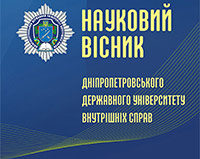Vitaly SEREDYUK
SEREDYUK V. (2022), Legal maxims as independent legal phenomena and their role in the interpretation of legal norms, Scientific Bulletin of Dnipropetrovsk State University of Internal Affairs, №4, 106-110
DOI: 10.31733/2078-3566-2022-4-106-110
ABSTRACT. The purpose of the article is to carry out an analysis of key approaches and methods that reveal the essence of the legal maxim in the interpretation of legal norms for the purpose of its comprehensive study. The novelty of the article lies in the theoretical understanding of maxims as independent legal phenomena and showing their role in the interpretation of legal norms.
It has been found that in the substantive aspect, the maxim describes a regularity discovered and substantiated by legal practice. Logically, the maxim is a logical model of the optimal state of various elements and aspects of legal practice: the goals of law, the properties of the law itself, the legal force of evidence, guarantees of a fair resolution of a legal case, etc. It has been established that the maxim is regarded as a special type of aphorisms based on their generic affiliation. In this sense, it acts as a literary form capable of recording and articulating a certain legal content meaningfully and succinctly in an artistic metaphorical form. At the same time, maxims do not include all aphorisms about law, only those related to the Roman legal heritage and expressed in Latin.
Maxims are independent legal phenomena, general rules-norms with a higher level of normative generalization, which cannot be equated with modern principles of law, since the latter are characterized by the accuracy of wording, a higher level of abstraction, and the ability to deploy content in normative prescriptions of a lower level. Maxims, unlike principles that require interpretation, establish a connection with the relevant context.
The identification of maxims with legal principles is rather a tribute to tradition, caused by the terminological practice associated with the lack of a suitable term for its designation. Maxims are able to act as means of revealing the content of principles, through them a certain principle can be deployed in the processes of knowledge or study of law.
Keywords: legal maxim, legal principle, linguistic maxims, common law, legal axiom.
References:
- Zyablova, T. E., Mamchun, V. V. (2021) Pravovaja maksima kak logiko-jazykovyj fenomen [Legal maxim as a logical and linguistic phenomenon.]. Gumanitarnyye, sotsyal’noekonomicheskiye i obshhestvennyye nauki. Pravo. № 5, pp. 122–124. [in Russ.]
- Onyshhuk, I. I. (2019) Tehnika jurydychnogo pys’ma v normatyvno-pravovyh aktah: monografija [Technique of legal writing in legal acts: monograph]. 2-e vyd., ster. Kharkiv : Pravo,. 226 p. [in Ukr.]
- Nalichnikova, I. A. (2018) K voprosu otlichiy aforizmov ot rodstvennykh zhanrov(literaturnykh tsytat, sententsyy i maksim) [On the question of differences between aphorisms and related
genres (literary quotations, maxims and maxims)]. Integratsyya nauk. № 7(22), pp. 14–17. [in Russ.]
